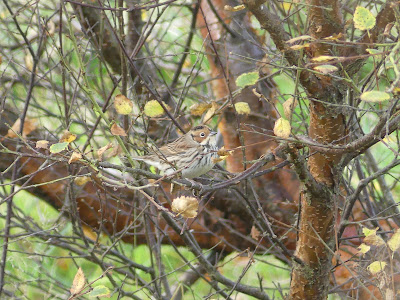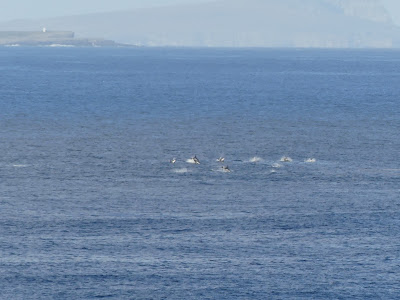We started our journey the day before as catching the ferry would have been a bit of a push had there been traffic delays. This did give us to see the Steppe-grey shrike at Dunbar on the way.
Our overnight sailing got us to the Shetland mainland quite early so we took a walk by Clickimin loch hoping to turn up some migrants. We did find some redpolls but nothing else. Thankfully, as time went on we were rather luckier, not finding any of the real rarities, but managing to see the Lanceolated Warbler at Levenwick, and the Pallas's Grasshopper Warbler at Maywick. Both times we were nearby and arrived for the first group efforts to see them. We also got to the Pechora Pipit at Quendale Mill on its first day.
We went to a few places to find YBWs, the Grutness garden included, and saw well into double figures by the end of the fortnight. Of course, nothing beats finding your own and we managed this at a few locations, including the garden at Wadbister where we were staying.
We found a couple of Barred Warblers of our own, both being first year individuals.
Even managed to find our own Pied Flycatcher at Strand.
Among the scare and common birds that we managed to get, off the Whatsapp group were the following species.
Common Rosefinch at burn of Sound
Siberian Chiffchaff at Quendale
Lesser Whitethroat at Grutness, may be accepted as eastern
Litte Bunting, burn of Sound
We couldn't help but end up in a few twitches, quite unusual for us. In the absence of a decent image of the bird, here is the Eastern-crowned Warbler twitch.
A few of the crowd for the Eastern-crowned Warbler
An indication of how flighty and difficult the bird was to see.
Scopes were useless.
It took a lot to keep many of those lacking in fieldcraft off the grass.
We were some of the few who saw the Lanceolated Warbler other than the finders.
No photo of the birders trying for PG Tips, across fields, fences and in the rain.
This was the best I could do of the bird.
Common birds were always there to draw the eye and keep us on our toes.
Male Blackcap
Another terrible record shot, this time of Corncrake at Tingwall.
We found the juvenile in the road later in the week but it had internal injuries and died while in our care. The corpse will go to the Shetland museum.
House Sparrows
Starlings
Female Blackbird
One of the highlights didn't involve birds at all. We were at Grutness when a report of White-beaked Dolphin heading through the Sound of Mousa came through. We picked out spot and hoped to see them.
White-beaked Dolphins.
The pod was assessed by drone as they rounded Sumburgh head and classed at a super-pod of 250+ animals. We also saw, using the scope, three distant but clearly Orca, two bulls and a third smaller female. No wonder the dolphins were moving so fast. From our vantage point we could see the pod split into two groups. Most were jumping clear of the water at first creating splashing as they passed Mousa, then some peeled off continuing to move the same way into a bay while the bulk of the pod swam less obviously, possibly slower without splashes southwards. It looked to me like a distraction ploy, but the Orcas never came that close and the smaller group soon returned from the bay and rejoined the pod.
We did take the nets and there will be a blog of our captures. Species selection is restricted and much more pedestrian than some of the racy little birds we managed to see.


















